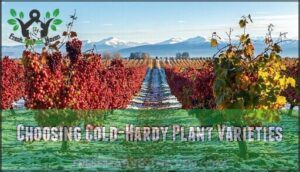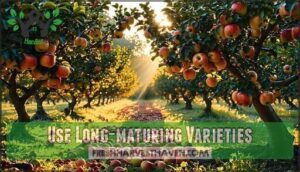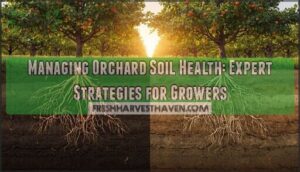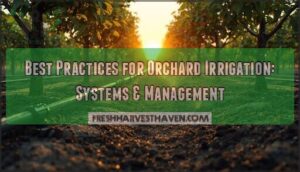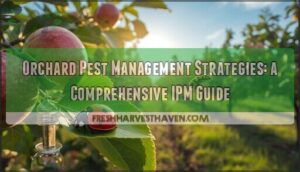This site is supported by our readers. We may earn a commission, at no cost to you, if you purchase through links.
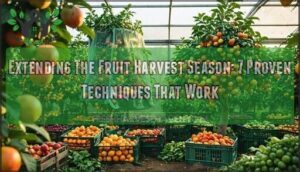
Start early with cold frames, row covers, and heat-retaining mulches to protect spring blossoms from late frosts.
Plant varieties with staggered maturity dates—early, mid, and late-season cultivars guarantee continuous production.
For fall extension, choose cold-hardy varieties and use protective structures like hoop tunnels or greenhouses.
Succession planting every two weeks keeps berries coming, while proper pruning encourages multiple flushes in everbearing types, which can add months to your harvest window, transforming your garden’s productivity in ways that might surprise you with smart microclimates and season extenders.
Table Of Contents
- Key Takeaways
- Extending Fruit Season
- Top 4 Season Extenders
- Choosing Right Crops
- Effective Garden Management
- Frequently Asked Questions (FAQs)
- What is the meaning of extended growing season?
- How can you extend the growing season?
- What is the meaning of harvest season?
- Which fruit takes the longest to harvest?
- How do I prevent birds from eating ripening fruit?
- Whats the best way to store harvested fruit?
- When should I water fruit trees during harvest season?
- How do I know when fruit is perfectly ripe?
- Can I grow fruit trees in containers successfully?
- Conclusion
Key Takeaways
- You’ll extend your fruit harvest from weeks to months by planting early, mid, and late-season varieties together, creating continuous production through strategic timing rather than relying on single-variety plantings.
- You can protect your crops and extend seasons using cold frames, row covers, greenhouses, and succession planting every 2-3 weeks to maintain steady harvests throughout changing weather conditions.
- You’ll maximize productivity by selecting cold-hardy varieties like Haskap berries and Fuji apples that naturally ripen later and withstand frost, combined with proper mulching to stabilize soil temperatures.
- You can create optimal growing conditions by choosing sunny, well-drained locations with wind protection, then using tools like automatic greenhouse vents and garden netting to maintain ideal microclimates for extended harvests.
Extending Fruit Season
You can dramatically extend your fruit harvest season from early spring through late autumn by using strategic timing and protective techniques.
These proven methods help you enjoy fresh, homegrown fruit for months longer than traditional growing allows, and can dramatically extend your harvest, allowing for a longer period of fresh fruit.
Techniques for Early Harvests
Getting ahead of Mother Nature requires smart timing and the right tools.
Early-Season Varieties like ‘Earliglow’ strawberries ripen 7-14 days sooner than standard types.
Greenhouse Microclimates and Heat Reflectors boost soil temperatures by 5°C, while Spring Pruning stimulates growth.
Grafted Trees on dwarf rootstocks fruit earlier, giving you that coveted early harvest advantage.
Some growers specialize in early strawberry products for the best prices.
Techniques for Late Harvests
You’ll extend your harvest well into autumn by selecting late varieties like Fuji apples and Bosc pears.
Delay pruning to slow growth cycles, while shade cloth reduces sunlight exposure to postpone ripening.
Install cold frames around trees to create protective microclimates against early frosts.
Frost blankets provide additional safeguarding for late-season fruits, ensuring your harvest extension techniques deliver fresh produce longer.
These trees help extend the fruit season, reducing reliance on store-bought produce.
Additional Strategies for Extending The Fruit Season
Beyond choosing early or late varieties, you can maximize your harvest through strategic planning.
Smart growers know that timing isn’t everything—it’s the only thing that matters for extending harvest periods effectively.
- Successive Planting: Stagger plantings every 2-3 weeks with varieties having different maturity dates
- Dwarf Varieties: Select compact trees that mature faster and allow easier management throughout seasons
- Proper Pollination: Plant compatible varieties with synchronized bloom timing for maximum fruit set
- Technique Combinations: Mix early and late harvest methods for continuous production cycles
To further enhance yields, consider protected cultivation methods such as hoop houses.
Top 4 Season Extenders
You’ll need the right tools to keep your fruit trees producing from early spring through late fall.
These four season extenders protect your harvest from weather extremes while creating ideal growing conditions that naturally extend your fruit’s productive window.
1. JINGOU Automatic Greenhouse Vent Opener
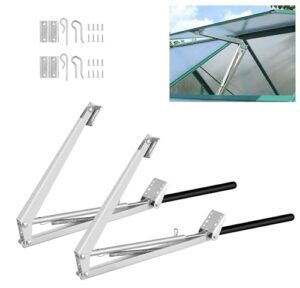
Temperature control is essential for extending your harvest window, and this automatic vent opener acts like a reliable greenhouse guardian.
Smart timing and protection methods turn basic gardens into year-round fruit machines.
The JINGOU opener activates at 77°F, expanding its wax cylinder to lift vents up to 15 pounds without electricity or batteries.
You’ll see consistent airflow that prevents heat stress and reduces fungal diseases by up to 25%.
Installation takes under 30 minutes on most greenhouse frames, and the corrosion-resistant construction typically lasts 2-5 years with minimal maintenance required.
Best For: Greenhouse growers seeking automated temperature control to reduce daily maintenance while extending harvest seasons and improving crop yields.
- Mixed reliability reports with some units lasting only one season due to quality inconsistencies
- Installation challenges reported, sometimes requiring modifications and missing assembly instructions
- May not fit all greenhouse vent designs without custom adjustments
- Solar-powered automation eliminates manual vent adjustments and operates without electricity or batteries
- Reduces fungal diseases by up to 25% through consistent airflow and prevents heat stress damage
- Quick 30-minute installation with durable construction lasting 2-5 years in most conditions
2. Jevrench Garden Netting Plant Cover

How effectively can mesh protect your precious fruit?
Ultra-fine garden netting creates an impenetrable barrier against insects and birds, reducing crop loss by up to 90%.
This transparent PE mesh allows sunlight, water, and air through while blocking pests that damage late-season harvests.
You’ll extend your picking window by 7-10 days as the netting’s microclimate effect promotes continued ripening.
Its UV-stabilized fibers withstand multiple seasons of use, making it a cost-effective investment for serious gardeners.
Best For: Gardeners who want to protect their fruits and vegetables from pests while maintaining natural growing conditions without chemical pesticides.
- Reduces crop loss by up to 90% while allowing sunlight, water, and air through
- Extends harvest window by 7-10 days through microclimate warming effect
- UV-stabilized material lasts 3-5 years with proper maintenance
- Can fray at edges and tear easily in windy conditions
- Some users report the material being thinner than expected
- May affect garden aesthetics with visible mesh covering
3. Landscape Mulch and Rock Bond Glue
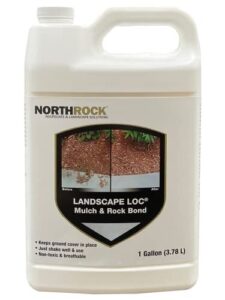
Landscape mulch and rock bond glue consistently transforms scattered ground cover into a cohesive protective layer.
You’ll apply this water-based adhesive to secure mulch around fruit trees, creating stable moisture retention and weed suppression for 6-12 months.
The formula covers 250-750 square feet per gallon, drying clear within 48 hours.
It’s particularly effective for maintaining consistent soil temperature and reducing water evaporation around your fruit plants, supporting extended growing seasons without frequent reapplication, which leads to an overall effective solution.
Best For: Homeowners with fruit trees and garden beds in low-traffic areas who want long-term mulch stability without frequent maintenance.
- Frequently clogs sprayers due to thick consistency and requires vigorous shaking, making application challenging
- Performs poorly in high-traffic areas or under heavy water exposure, with water-soluble formula breaking down over time
- High cost per gallon with variable coverage (250-750 sq ft) makes it expensive for larger landscaping projects
- Provides 6-12 months of effective mulch and rock stabilization, reducing displacement from wind, rain, and garden equipment
- Improves moisture retention and soil temperature regulation, supporting healthier fruit plant growth and extended growing seasons
- Non-toxic, EPA-compliant formula that’s safe for use around edible plants, pets, and children
4. Miracle-Gro Organic Mulch for Landscaping
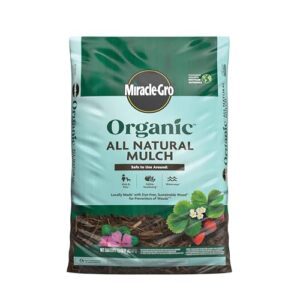
Miracle-Gro’s organic mulch transforms your fruit garden into a moisture-retaining powerhouse.
This OMRI-certified blend cuts watering needs by 25% while blocking 90% of weeds that steal nutrients from your precious fruit trees.
You’ll see soil temperatures stabilize, extending your harvest window by 7-10 days as roots stay protected from early frost.
To further protect from frost, consider using row covers for sensitive plants.
The decomposing organic matter feeds soil microbes, boosting activity by 30% for stronger root systems.
Apply 2-4 inches around trees, avoiding direct trunk contact to prevent rot issues.
Best For: Fruit gardeners and landscapers seeking an organic solution to reduce watering, suppress weeds, and extend growing seasons while improving soil health.
- Requires annual replacement or replenishment to maintain effectiveness, adding ongoing maintenance costs
- Cannot be applied directly against tree trunks due to rot risk, requiring careful placement around plants
- Individual Amazon packaging creates unnecessary waste compared to bulk in-store purchases
- Cuts watering needs by 25% and blocks 90% of weeds, reducing maintenance time and competition for nutrients
- Extends harvest window by 7-10 days through soil temperature regulation and frost protection for roots
- OMRI-certified organic composition feeds soil microbes, boosting microbial activity by 30% for stronger root development
Choosing Right Crops
You’ll dramatically extend your fruit harvest by selecting the right crop varieties for your climate and timing goals.
Smart variety selection combines early-season champions like Gravenstein apples with late-harvest stars like Fuji apples, giving you fresh fruit from spring through late fall.
Selecting Appropriate Fall Crops
You’ll achieve better results by understanding which fall crop families thrive in cooler conditions.
Cool-season vegetables like kale and Brussels sprouts handle frost better than summer crops.
Here’s your strategic selection guide:
- Fall Crop Families: Brassicas (cabbage, broccoli) excel in autumn temperatures
- Overwintering Crops: Garlic and shallots establish roots before winter dormancy
- Succession Planting: Stagger lettuce plantings every two weeks through September
- Late-season Fruits: Apples and pears naturally ripen during fall months
- Frost Tolerance: Root vegetables like carrots actually sweeten after light frosts
These late-season fruits and extending harvest strategies maximize your garden’s productivity.
Choosing Cold-Hardy Plant Varieties
Cold-hardy plant varieties transform your fruit harvest season by thriving where tender fruits fail.
These hardy champions like Siberian kiwi and Haskap berries withstand brutal -25°C temperatures while producing consistently.
Planting cold hardy vegetables can also extend the growing season.
| Variety | Hardiness Zone |
|---|---|
| Haralson Apple | 3-4 (-30°C) |
| Frontenac Grape | 3-5 (-35°C) |
| Honeyberry | 2-7 (-40°C) |
Your variety selection directly impacts frost resistance and microclimate adaptation.
Rootstock influence matters too—cold-adapted rootstocks boost survival rates substantially.
These extending harvest solutions guarantee lateseason fruits continue producing when others quit.
Effective Garden Management
You’ll maximize your fruit harvest by mastering four key garden management practices that work together like a well-oiled machine.
Smart location selection, strategic planting schedules, variety choices, and proper mulching can extend your fruit season from early spring through late fall, utilizing smart techniques to enhance productivity.
Selecting Optimal Garden Locations
Your garden’s location determines fruit production success more than most gardeners realize.
Smart positioning creates favorable microclimates that naturally extend harvests without expensive equipment.
Consider these four critical location factors:
- Sunlight Exposure – Position fruit trees where they’ll receive 6-8 hours of direct sunlight, with southern slopes offering the longest growing periods
- Water Access – Choose spots within 100 feet of reliable irrigation to maintain consistent moisture during extended seasons
- Soil Drainage – Select elevated areas or slopes where water doesn’t pool, preventing root rot during wet autumn months
- Wind Protection – Plant near existing windbreaks or structures to reduce cold air movement and protect developing fruit
Stagger Planting With Varied Maturities
Smart succession planting transforms your garden into a harvest machine.
Strategic timing beats chance every time—plant smart, harvest longer.
You’ll plant the same variety every two weeks, creating staggered harvesting waves that keep fruit coming for months.
Choose varieties with different maturity dates—early, mid, and late-season types extend your continuous harvest window.
This varietal selection strategy, combined with proper planting intervals, maximizes your growing space while ensuring fresh fruit from spring through fall.
Consider also local frost dates for ideal planting schedules.
Use Long-maturing Varieties
Three proven Late-Season Fruits maximize your harvest window through strategic Variety Selection and delayed ripening techniques.
Choose varieties like Fuji apples and Bosc pears that naturally extend fruit ripening control into late autumn.
These selections offer superior Storage Potential and enhanced Flavor Development despite Growing Challenges, ultimately extending shelf life while maintaining exceptional fruit quality maintenance.
Consider exploring options for late season apples to further extend your harvest.
Selecting Effective Mulch Materials
Your choice of mulching materials dramatically impacts soil health and season extension success.
Organic mulches like straw and wood chips decompose gradually, improving soil structure while maintaining consistent moisture levels.
Straw mulch reduces fruit cracking by up to 40%, while wood chips lower soil temperatures during summer heat.
Consider purchasing straw mulch for your garden.
Apply mulch at proper thickness—5-10 cm depth optimizes weed suppression without promoting root rot.
Inorganic mulches provide different benefits for fruit tree cultivation.
Frequently Asked Questions (FAQs)
What is the meaning of extended growing season?
An extended growing season means you’re stretching your garden’s productive time beyond the typical frost-to-frost window by using protective structures, strategic plantings, and climate modifications.
How can you extend the growing season?
Don’t put all your eggs in one basket—diversify your planting schedule.
Use protective structures like cold frames, row covers, and greenhouses.
Plant succession crops, choose varieties with different maturity dates, and create warm microclimates.
What is the meaning of harvest season?
Harvest season refers to the period when you collect mature crops from your garden or farm.
It’s nature’s payoff time – when fruits, vegetables, and grains reach peak ripeness and you’re ready to gather them for eating, storing, or selling, which is the harvest season.
Which fruit takes the longest to harvest?
Tree fruits like apples and pears can take months to fully ripen from initial fruit set, with some late-season varieties requiring 150-180 days to mature properly for harvest.
How do I prevent birds from eating ripening fruit?
You’ll need physical barriers like bird netting over trees, reflective tape that moves in wind, or decoy owls.
Row covers work well too.
Time your harvest right before peak ripeness to beat hungry birds.
Whats the best way to store harvested fruit?
Cool storage works best – refrigerate apples, pears, and stone fruits at 32-40°F with high humidity.
Store citrus at room temperature initially, then refrigerate.
Separate ethylene producers like apples from sensitive fruits.
When should I water fruit trees during harvest season?
Absolutely critical timing can make or break your entire harvest.
Water your fruit trees deeply but less frequently during harvest season, typically every 7-10 days, checking soil moisture first to prevent overwatering that dilutes flavors.
How do I know when fruit is perfectly ripe?
Check fruit’s firmness with gentle pressure – ripe fruit yields slightly but doesn’t feel mushy.
Look for color changes, sweet aroma, and easy stem separation.
Taste-test for ideal sweetness and flavor balance.
Can I grow fruit trees in containers successfully?
You can successfully grow fruit trees in containers using dwarf or semi-dwarf varieties. Choose large pots with drainage, use quality soil, and provide regular watering and fertilizing for healthy production.
Conclusion
Like a well-orchestrated symphony, extending the fruit harvest season requires careful timing and proper tools.
You’ve now learned seven proven techniques that’ll keep fresh produce flowing from your garden for months instead of weeks.
By combining cold frames, succession planting, and strategic variety selection, you’re equipped to maximize your harvest potential.
These methods aren’t just theory—they’re practical solutions that transform ordinary gardens into productive powerhouses that deliver consistent results throughout the growing season.
- https://www.backyardboss.net/extend-your-garden-harvest-into-late-summer/
- https://growgreatfruit.com/apple-tree/plant-late-season-fruit-trees/
- https://pmc.ncbi.nlm.nih.gov/articles/PMC11882901/
- https://bloomranchofacton.com/pages/the-complete-guide-to-orchard-fruit-list-trees-and-picking
- https://www.walmart.com/ip/Garden-Netting-Jevrench-Durable-Ultra-Fine-Plant-Cover-Row-Makes-Plants-Vegetables-Fruits-Flowers-Grow-Better-4ft-x-25ft-C25/14171504302


